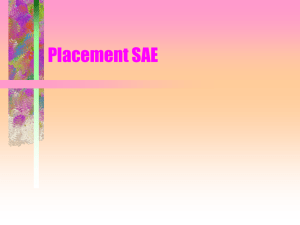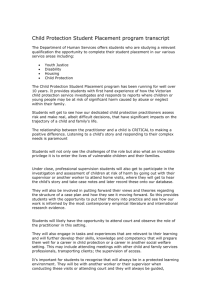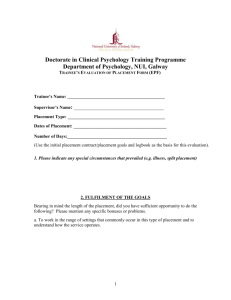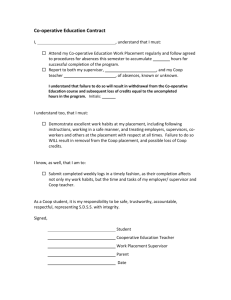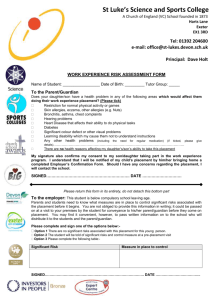Guidelines for Field Placement - York & Ryerson Joint Graduate
advertisement
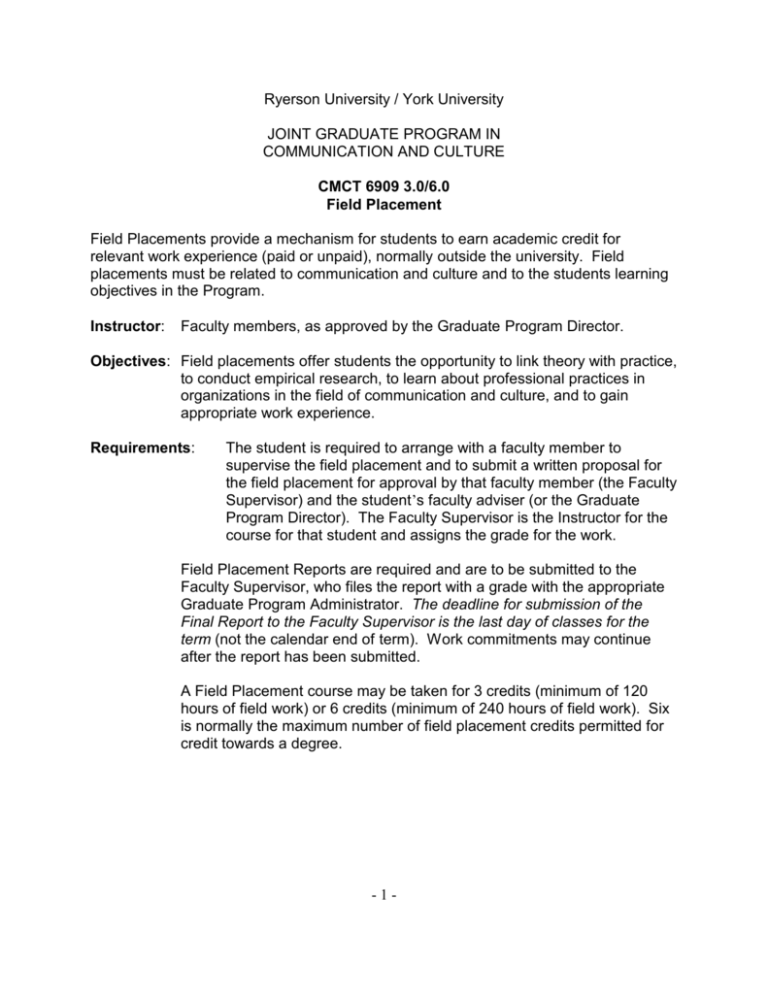
Ryerson University / York University JOINT GRADUATE PROGRAM IN COMMUNICATION AND CULTURE CMCT 6909 3.0/6.0 Field Placement Field Placements provide a mechanism for students to earn academic credit for relevant work experience (paid or unpaid), normally outside the university. Field placements must be related to communication and culture and to the students learning objectives in the Program. Instructor: Faculty members, as approved by the Graduate Program Director. Objectives: Field placements offer students the opportunity to link theory with practice, to conduct empirical research, to learn about professional practices in organizations in the field of communication and culture, and to gain appropriate work experience. Requirements: The student is required to arrange with a faculty member to supervise the field placement and to submit a written proposal for the field placement for approval by that faculty member (the Faculty Supervisor) and the student’s faculty adviser (or the Graduate Program Director). The Faculty Supervisor is the Instructor for the course for that student and assigns the grade for the work. Field Placement Reports are required and are to be submitted to the Faculty Supervisor, who files the report with a grade with the appropriate Graduate Program Administrator. The deadline for submission of the Final Report to the Faculty Supervisor is the last day of classes for the term (not the calendar end of term). Work commitments may continue after the report has been submitted. A Field Placement course may be taken for 3 credits (minimum of 120 hours of field work) or 6 credits (minimum of 240 hours of field work). Six is normally the maximum number of field placement credits permitted for credit towards a degree. -1- Prerequisites and Limitations: Field Placements are not normally open to PhD students. Field Placements are not normally permitted in the first term of study. Before a student registers for the term, formal approvals for the proposed Field Placement must be obtained from: 1) 2) 3) 4) the Faculty Supervisor (as Course instructor) the Field Supervisor the student’s faculty adviser (or the Graduate Program Director or MA Co-ordinator) the Graduate Program Director. The student must submit the form “Request for Enrollment in Field Placement” completed by the student, with signatures of approval from those listed above. NOTE: A student who conducts self-designed research or project activities under the direction of a faculty member without the involvement of an outside supervisor will normally be registered for Individual Directed Study rather than Field Placement. DEFINITIONS: 1. Faculty Supervisor: a faculty member of the Joint Graduate Program in Communication and Culture or other member of the Faculty of Graduate Studies (York) or School of Graduate Studies (Ryerson) approved by the Graduate Program Director. 2. Field Supervisor: the on-site person who is in charge of the student’s activities and obligations in the Field Placement. -2- Ryerson University / York University JOINT GRADUATE PROGRAM IN COMMUNICATION AND CULTURE Guidelines for Field Placement 1. The Nature and Objectives of Field Placements These are set out in the course description above. 2. 3. Guidelines for Project Formulation by the Student 1) The student is expected to seek an employment opportunity, a voluntary position, or work on project that is related to the study of communication and culture and the student’s academic objectives. This may be done independently or with the assistance of the Program. Present and former employers, professors, advisors, and members of the Program’s Advisory Council may be helpful in suggesting appropriate Field Placements. If paid employment is being sought, it is important to begin the search as far in advance as possible. Given the competition for jobs and co-op placements in communication and culture, even for voluntary internships, the Program is not in a position to guarantee that placements will be available. 2) The student should work with the Faculty Supervisor and the Field Supervisor to develop a work plan that will contribute to the student’s learning objectives (as noted in the course description). Enrollment Procedures for Field Placement 1) Complete the form “Request for Enrolment in Field Placement.” 2) Obtain the required signatures, as noted above. 3) Submit the approved form and other registration materials to the appropriate Program Office before the final date for enrollment. 4) When details of the Field Placement are unavailable prior to enrollment (for example, when the Field Placement is undertaken outside the Greater Toronto Area), these details may be provided as an Addendum to the request form within three weeks of commencement of the placement. 5) In rare cases, the terms of reference of the Field Placement may change -3- significantly once the student is involved in the field activity. In such cases, approval from the Graduate Program Director is required. Revised terms of reference must be submitted to the appropriate Program Office as soon as practicable. Approval is also required for a change in the Field Supervisor. 4. Sequence of Field Placement Activities 1) 2) 3) 4) 5) 6) 5. Formulation of the project and approvals. Enrollment. Periodic communication (meetings or other forms) with the Faculty Supervisor and the Field Supervisor, as stipulated in the Request for Enrolment in Field Placement. Keeping of a journal of log book to assist in preparing the required Field Placement Report. Preparation and submission of the Field Placement Report to the Faculty Supervisor and Field Supervisor, with a copy to the appropriate Program Office. Submission of a written evaluation and grade by the Faculty Supervisor (with the evaluation report from the Field Supervisor). Guidelines for Preparation of the Field Placement Report Each student enrolled in a Field Placement must prepare a formal Field Placement Report. Although the report may take a variety of forms, there are four fundamental questions that must be addressed: 1) 2) 3) 4) What did you do? Activities must be described in some detail. What did you learn? Describe and evaluate the learning experience, particularly in terms of substantive knowledge gained and skills acquired or refined. How did the experience contribute to your understanding of your areas of interest within Communication and Culture? The report should include reflections informed by relevant theoretical materials, where appropriate. What changes, if any, will you make in your academic work, course work, research plans, etc. as a result of the Field Placement? Append any materials, reports or case studies researched or prepared by you (in whole or in part) which may help to illustrate the nature of the Field Placement. (Confidential materials will held in confidence by the Program upon request. In cases where materials cannot be submitted at all, they must be described in as much detail as possible and reasons given for their omission from the report.) -4- The following outline is an example of the form that a Field Placement Report might take: 1. Introduction 1) 2) 3) II. The Experience 1) 2) 3) III. describe briefly your employment / research position, including your job title. describe the organizational setting and / or context of the Field Placement. describe the actual tasks and activities for which you were responsible. discuss and evaluate the organizational context in which you worked and your linkages with other departments, agencies and institutions. describe the best and worst features of the experience. discuss, on reflection, how you might have carried out your tasks and responsibilities to greater benefit. Consequences 1) 2) discuss in some detail the contribution of the placement to your academic and / or professional objectives, including (i) the substantive knowledge that you gained or strengthened during your placement and (ii) the specific skills, methods, and techniques which you used or acquired. discuss the influence, if any, of the placement on you personally, including your academic and professional goals, course selection, research plans, etc. Appendixes: Materials which illustrate the nature of the Field Placement. 6. Procedures for Submitting the Report 1) The report should be attached to the formal cover sheet, “Report on Field Placement” available from the Program Office or the program web site. 2) The report should be approved by the Faculty Supervisor before submission. The Field Supervisor’s Report should be attached. 3) There is no minimum or maximum length for Field Placement Reports, but a sensible guideline would be 12-15 pages for a 3-credit placement and 25-30 pages for a 6-credit placement. 4) The student may wish to be critical of some aspect of the placement. If -5- the student does not wish the Field Supervisor to read these comments, they may be included only in the copy submitted to the Faculty Supervisor. 7. 8. 9. Responsibilities of the Faculty Supervisor 1) To consult with the student during project formulation and preparation of the terms of reference for the field placement, which should include discussion of ways to ensure the learning value of the placement. 4) To undertake the role of Faculty Supervisor only for placements where he or she has the necessary expertise. 5) To ensure that the terms of reference are explicitly stated on the Request for Enrolment in Field Placement form and that these terms are accepted by the student, the Faculty Supervisor and the Field Supervisor. 6) To maintain regular contact with the student during the Field Placement, as specified in the Request for Enrolment in Field Placement form. 7) To maintain contact with the Field Placement Supervisor, as necessary. 8) To ensure that the Field Supervisor completes the Field Placement Evaluation form as a partial basis for the evaluation of the student. 9) To submit a grade and written evaluation of the student’s performance in the Field Placement to the appropriate Program Office. Responsibilities of the Field Supervisor 1) In agreeing to accept the Field Placement, the Field Supervisor must agree to provide a modest degree of academic supervision for the student. This involves ensuring that the Field Placement provides a useful and relevant experience for the student. 2) Preparation of a Field Placement Evaluation to be submitted with the Field Placement Report at the end of the term of the Field Placement to the Faculty Supervisor. The Evaluation verifies the task description provided by the student and provides a few lines of work assessment. An appropriate form will be provided to the Field Supervisor by the student. Responsibilities of the Student 1) To formulate, in consultation with the Faculty Supervisor and Field Supervisor (and Faculty Advisor, when appropriate), an appropriate -6- research / professional project or work Program related to the student’s learning objectives. 2) To secure the required signatures on the completed Request for Enrolment in Field Placement, prior to registration. 3) To maintain contact with the Faculty Supervisor and Field Supervisor, as specified in the Request for Enrolment in Field Placement. 4) To prepare the Report on Field Placement in accordance with the guidelines set out above. 5) To submit the Report on Field Placement to the Faculty Advisor by the last day of classes for the term of the placement. -7-

